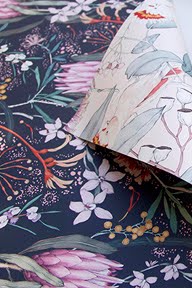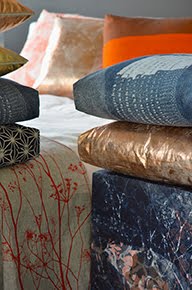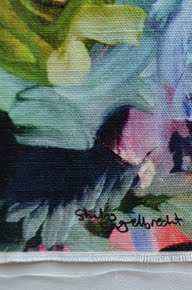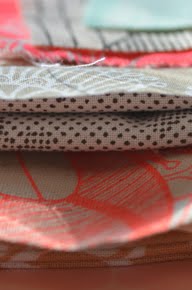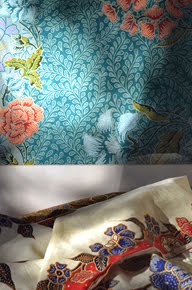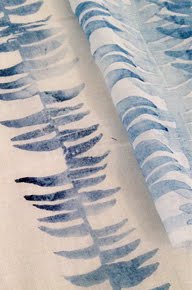
The work of Shuh Lee brings a smile to the face and a dance to the heart. Colour, shapes and doodles come together on a wide array of decorative objects, each one joyous and playful. Malaysian born, this charming young woman spent her childhood and college days in Kuala Lumpur before making the move to Melbourne to study fashion at RMIT. The new chapter introduced the concept of working with non traditional and available materials. And as Shuh started to develop her distinct style, it is certain that fond moments watching her father mix paints in his printing studio during her youth contributed to the kaleidoscope of colours that have now become her trademark.
Sometimes starting with only scissors, glue, paint and string, Shuh lets her work create itself into existence by following her fun. She uses a variety of techniques – including hand stitching, printing, illustration, fashion design, leaving and collage – and creates small and original lines of work under the label Shuh. that have included painted pots, oversized ropes, a Confetti Dress and a Cucumber Card. Stripes, polka dots and squiggles adorn cushions, pillow cases, gift wrap, stationary, scarves and clothing, and her hands have woven threads, beads, repurposed fabric and rope into one-off bracelets, earrings and baskets.
Shuh is closely connected to her community, with whom she has regularly exhibited and sold her work. alongside other talented makers, and completed a gorgeous collaboration with rope artist Gemma Patford in August 2015. Looking forward, she hopes to soon launch a range of bed linen, sure to sit cheerfully alongside organic cotton pillow cases already in her collection that reference Shuh’s playful approach to collage. It’s no wonder this label has caught the eye of Frankie, Yen and Broadsheet, and with textile pieces like ‘Ugh Faces’ cushions, the ‘Burger Dreams’ print and ‘Funny Girl Bolster’ (complete with long fringe and teethy grin), it is fun to ponder where her work will focus next!
What made you move to Australia to study fashion? How did you adapt and find comfort here?
I wanted to learn and get out of my comfort zone. Before Australia, I was just having fun during my college days. It was fun but not fulfilling on the inside and I knew I needed to find my true self. I took up Fashion Design during college (they did not offer a degree back then) so I decided to further my studies in Australia. I chose Australia so I wasn't too far from my family. It was not easy leaving home for the first time. It took me a few years to adapt and feel at home. I am always grateful to the people I have crossed paths with for giving me the experience to learn about myself and through that I found my second home here.
Tell me about your study? What did you gain from your degree and what were your favourite subjects and tasks?
I studied at RMIT University, Melbourne. My favourite subjects were Tailoring and Accessories. Tailoring was hard but it is usually the difficult ones that are most rewarding. Besides drafting and sewing a jacket, we had to sketch the inside and outside of a jacket to get a better understanding of it. That was one of my favourite bits, we got to admire the workmanship of a tailored jacket in detail. I still get goosebumps when I come across a well made piece of clothing.
Accessories was an elective and turns out is not just about making an earring or a necklace with beads. We had unusual and recycled materials like plastic caps, plaster and wires to work with. Through that, I was very inspired about reusing unwanted objects and working with unconventional materials, which I still apply to my work whenever possible.
Just briefly, how do you describe your work?
My work is about playing with a mixture of art and craft, and sometimes re-purposing material objects into something usable, wearable and fun.
You have a very distinct style - how has this developed over time? Have you always made things?
It has definitely developed over time. I have picked up some elements that I am comfortable with over the years through my school and personal projects, like the use of colours. I used to sell my work and second hand goods at the local weekend market. From that I got a feel of what people like and what works for me.
Tell me a little about your process? How do you start? And how does your work evolve?
The process always starts with me just playing with paint and materials that I have. I love working with fine liner, acrylic or poster colour on paper for my prints. Sometimes, I will use vinyl or sticker to add onto the artwork. Eventually the work will start to evolve and I will pick a couple of good pieces to work on. I then transfer them onto Photoshop to develop them further. I play with the layers by collaging different artworks on top of each other. Some work is ongoing while some pieces get finalised for printing. I also try to note my ideas in a sketchbook so that I can work on them when I have time.
How has your upbringing influenced your work?
When I was young, I have always enjoyed art subjects in school. I remember contributing artworks regularly for my club's newsletter (I was in the Interact club) or competing in local art competitions! It is always good fun when my work is chosen. I still keep some of my old work in my parent's home in Kuala Lumpur. I love going through them for a laugh and good memories.
Seeing my father work as a commercial silk screen printer has also sparked my curiosity in paint and colours. He prints on different mediums, depending on the project, which I guess has influenced me in producing a range of different products. When he took on extra commissions, my siblings and I would give him a hand in the workshop. We normally helped him move the printed objects onto the drying rack. The process can be repetitive, especially if there are a few colours! It is a lot of hard work but I am grateful for the first hand experience. My favourite time is watching him mix the paints to get the right colour.
What is your favourite thing to make and why?
One off necklaces or earrings. I treat it as a project for my play time. There are no rules or time limits; I just love putting materials together and stitching while having YouTube or SBS On Demand playing in the background. Bliss!
You produce a wide variety of products - including paper, cards, bed linen, jewellery and clothing - what motivates you to dabble in all of these forms?
I like to create a story with my work. When I work with a print, I would start to picture what product it would work well on or sometimes I would have a wishlist product that I would like to produce. It is a trial and error but always good fun to experiment.
How are your creations transferred to textiles?
I normally use offset/digital printing and screen printing.
Tell me about your relationship with colour?
I can't work without it. The colours I work with represents how I feel and in return it gives me a lot of joy when I see a beautiful combination of colours. It adds life to my work.
What is your favourite colour?
I am afraid I have more than one! I am always drawn to indigo blue, chambray, pale grey and anything pastel.
And finally, where would you like to take your label in the future?
I would like have a more complete range of clothing and bedding. I hope to find people/manufacturers who can turn my vision into reality. Also, I would love to keep collaborating with different makers and brands.
Images courtesy of Shuh. Photography by Ben Christensen and Jem Selig Freeman.
























